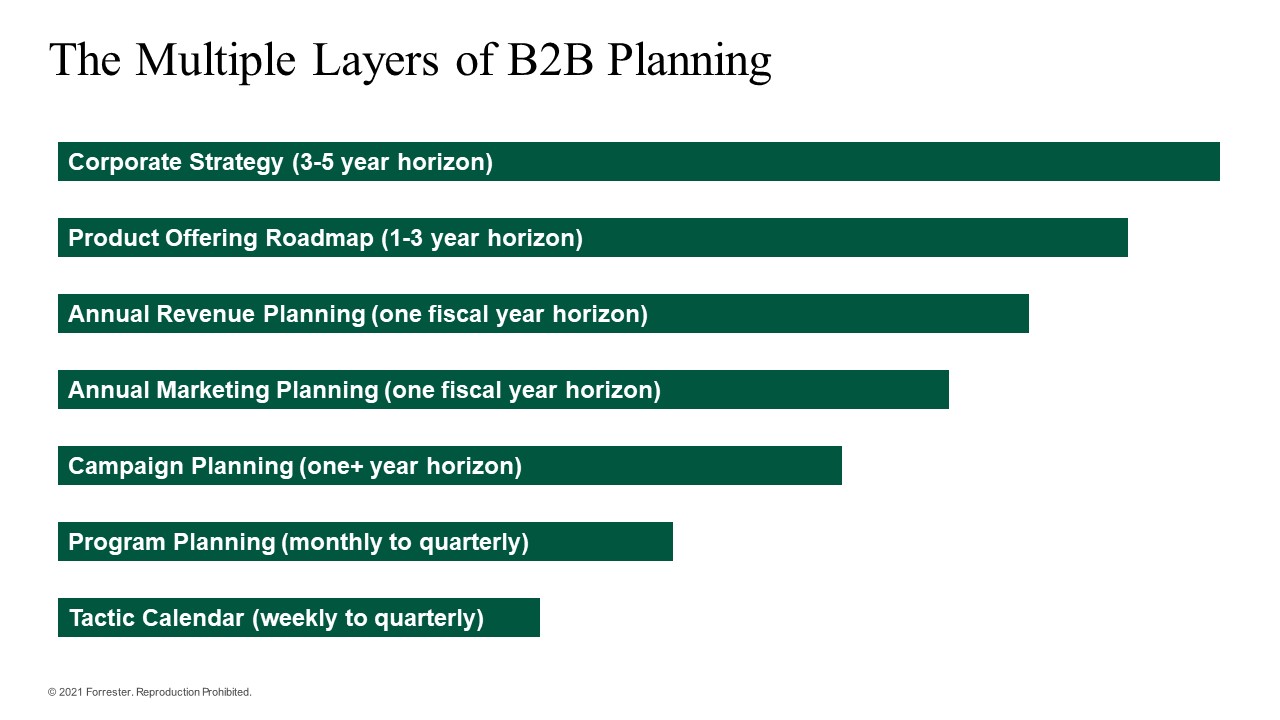To Build A Better Marketing Plan, Revisit Your Approach To Planning
There’s a great quote attributed to US President and five-star General Dwight D. Eisenhower that goes, “In preparing for battle, I have always found that plans are useless, but planning is indispensable.” Interestingly, the same can be said of marketing annual planning. When the fiscal planning process comes around every year, marketing leaders often find themselves spinning up long lists of tactics and packaging them up as the plan. The connection between these tactics and what the business needs from marketing may be tenuous, and in the months that follow, the plan is either pursued with little meaningful impact or it gathers dust on a shelf.
Fortunately, there’s a fix for this — and it involves leaning into the “planning” rather than the “plans.” The first step is to acknowledge that marketing can’t do it all on its own; driving meaningful change takes input from the C-suite and other areas of the business. It also takes building flexibility into planning. Conditions change, both in the market and internally, and marketing needs to be flexible enough to respond. Traditional approaches to plan development aren’t very helpful in striking that balance.
Dynamic Marketing Planning: The Key To A Better Plan
This more agile approach — dynamic marketing planning — starts with big-picture questions such as: Where do we want to go in the next 12 months? How will we drive growth? What are the overall business goals? These guiding questions give marketers a destination, a starting point for meaningful annual planning. For example, if the company wants to grow revenue in a certain market segment by a certain amount, marketing decides what it will do to support that objective. If the first approach doesn’t work, you have the flexibility to change it.
Three steps are key to a successful dynamic marketing planning approach:

1. Structure Your Planning Horizons
Planning works best when it has defined, sequential levels (as shown above), with clear communication at each.
Many marketing organizations we work with focus on the fourth step (annual marketing planning) and the last step (tactics), skipping the others. Silos are largely to blame: A long-term corporate strategy often exists, for instance, but no one outside of the C-suite may know about it. Similarly, marketing typically knows about upcoming product releases but might lack insight into the longer-term product roadmap. And because revenue planning often happens in parallel with marketing planning, revenue targets may not be available to incorporate into the marketing plan. Without the grounding of these steps, marketing planning happens in a vacuum.
Marketers often also skip over campaign planning and program planning. I’ll dig into these two steps in a moment, but it’s important to note that they help you think through who your audience is, what their needs are, and what your narrative is. Working through those steps gives purpose and organization to the tactics. They save you from performing random acts of marketing.
2. Develop And Adopt A Clear Taxonomy
Building an effective marketing plan takes a common vocabulary. Think of the word “campaign”: How many times have you heard phrases such as “the campaign for product x,” “email campaign,” or “whitepaper campaign” (even within your own organization)? At Forrester, we think about campaigns in a big-picture sense: as tied to a theme based on who you’re selling to and what the buyer need is that you’re addressing. They’re much broader than individual tactics. Once you’ve defined a campaign, you can then shift focus to programs, which are coordinated sets of tactics aimed at achieving quantifiable goals. Programs might aim to build reputation on a certain theme; drive demand toward that area; build engagement among existing customers; or enable sales and channel partners. They all center on the campaign theme and are rooted in buyer needs.
Achieving a common vocabulary makes it easier to categorize and discuss marketing initiatives. When someone refers to a campaign, everyone knows what that means. When a team discusses tactics, they are tied to specific programs and overarching campaigns for clarity and context.
3. Cascade Marketing Plans Down To Tactics
Once you’ve determined what marketing will do to deliver on business objectives, you can then set forth specific, recommended guidance to round out your marketing plan. Forrester’s Marketing-Plan-on-a-Page template is a useful tool that can help you communicate the marketing plan and show how marketing’s actions ladder up to the business objectives. Your tactics become specific and focused, rather than scattershot. They serve a clear, big-picture purpose rather than being ends unto themselves.
Most of all, you have more room to experiment based on what’s working and what isn’t. When you’re guided by overarching objectives rather than a rigid commitment to particular tactics, you have the freedom to halt a tactic, or swap a new one in, if what you’ve planned isn’t showing the results you want. And that brings me to my final point: For dynamic marketing planning to be truly dynamic, you should review your plan periodically. Quarterly or perhaps even monthly, you can evaluate what’s working and what isn’t and see what adjustments should be made to stay on target.
This approach takes work — don’t get me wrong. Marketing will need to gain alignment with other functions that may be accustomed to working in silos. But put in the time, and you’ll see your annual planning process transform. Instead of a well-meaning but detached set of tactics that might gather dust, you’ll come out with a meaningful set of actions that drive measurable results for the business. And isn’t that precisely what marketing is meant to do?
